Madame Adélaïde (1732-1800) was one of Louis XV’s children. As such, she was a “Daughter of France,” and was accorded a truly royal apartment in the main block of the Château.
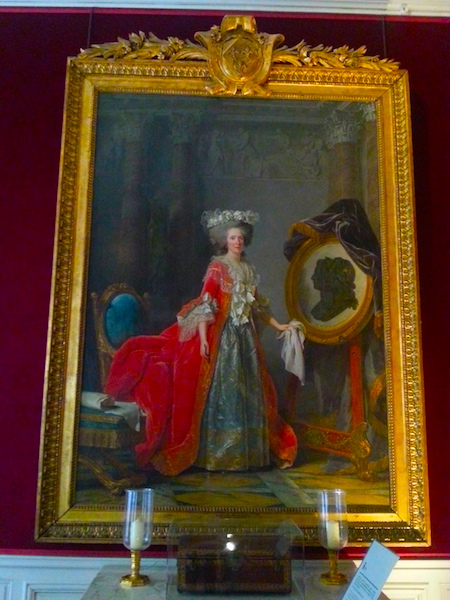
Portrait of Mme Adélaïde in 1787 by Adélaïde Labille-Guiard. It hangs in her sister’s apartment at Versailles.
Her apartment adjoins that of her younger sister, Mme Victoire (1733-1799). I previously described Mme Victoire’s apartment in an early post on this blog: http://versaillescentury.com/2016/09/22/versailles-mme-victoires-apartment/#more-304
The 2 sisters were the last of Louis XV’s offspring still alive and living in the Château towards the end of the reign of their nephew, Louis XVI. The latter also gave them the Château de Bellevue, and, unprecedentedly, the joint dukedom of Lauzun. The layout of the rooms today is as it was arranged for the sisters in the 1780s.
Let’s begin our tour of Mme Adélaïde’s apartment. The first room is a library. When you visit the Château today, this room is labeled “Mme Victoire’s Library.” In fact, however, the sisters shared it. Mme Victoire’s books were bound in green leather and Mme Adélaïde’s in red. It evidently also functioned as the link between their apartments.
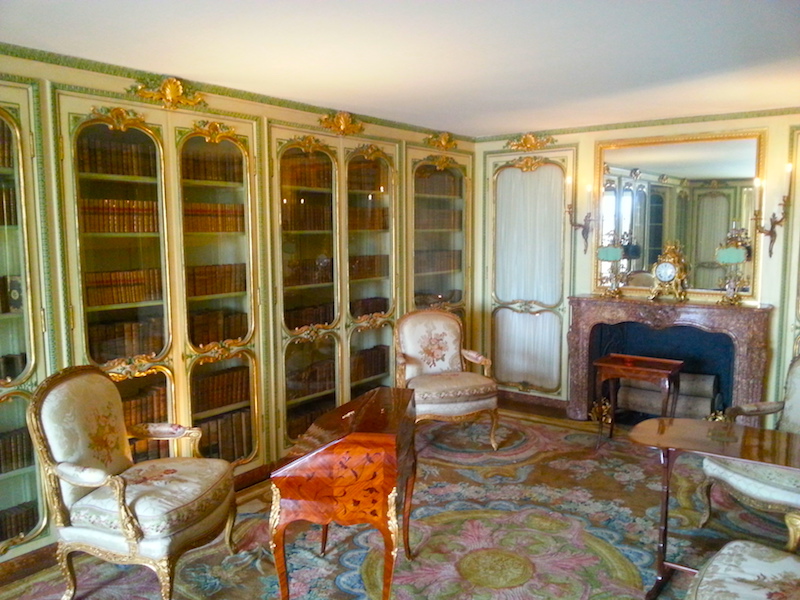
The left side of Mesdames’ library, nowadays called “Mme Victoire’s Library.”
The door to Mme Victoire’s rooms is on the right side of the photo above (out of frame) and the door to Mme Adélaïde’s is to the left (also out of frame).
The next room is Mme Adélaïde’s cabinet intérieur, her inner sitting room.
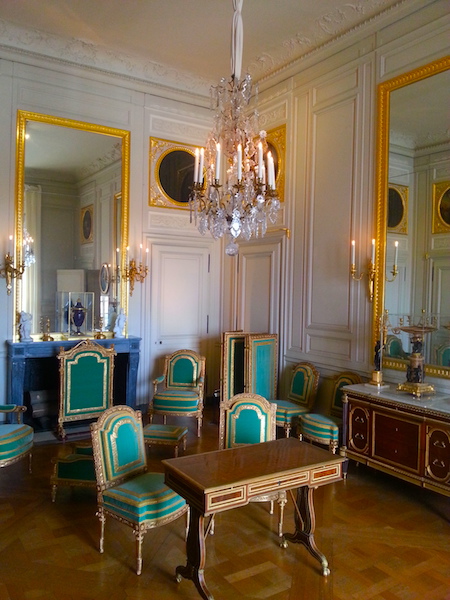
Mme Adélaïde’s inner sitting room.
This room, once part of Louis XIV’s bathing chamber, is the smallest room of Mme Adélaïde’s apartment. It was presumably here that she received her closest friends and intimates. The magnificent suite of furniture that we see here today is from Marie-Antoinette’s rooms at St. Cloud, a chateau she had only begun to decorate shortly before the Revolution. Mme Victoire had a corresponding sitting room on her side of the library.
The subsequent room is Mme Adélaïde’s bedroom.
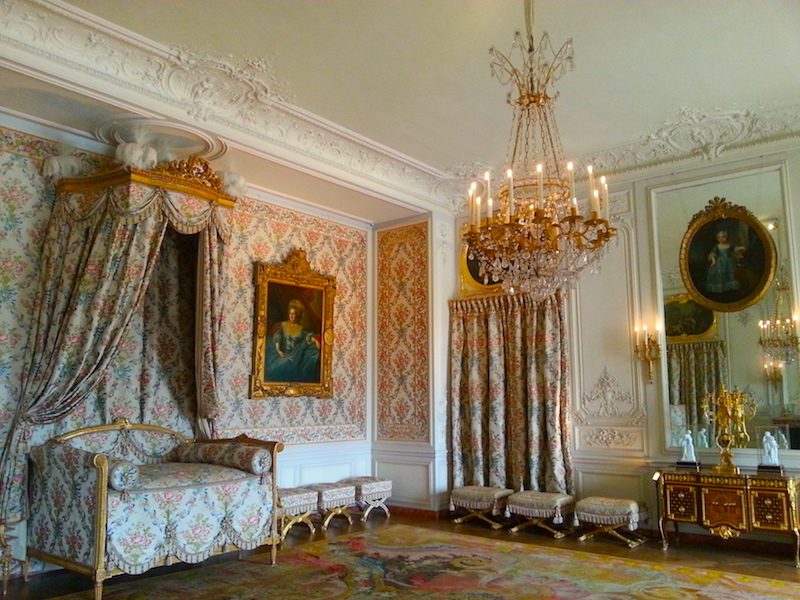
Mme Adélaïde’s bedroom.
The first thing to note is that the bed is on loan from the Louvre. In Mme Adélaïde’s day, there was a larger bed placed perpendicularly to the wall, under the canopy. The bed, the canopy, the walls, and the curtains are dressed in a reproduced silk. Interestingly, these hangings, called le mobilier, were changed twice a year. These are the summer hangings. Very little of the furniture here today actually belonged to Mme Adélaïde. The stools, for instance, are nineteenth century, placed here as stopgaps until appropriate period furniture can be found. The side table and the candelabra on its surface (see above at right), however, was at the sisters’ chateau at Bellevue. The memoirist and author Mme de Boigne (1781-1866), who was born at Versailles and whose mother was one of Mme Adélaïde’s ladies in waiting, wrote of her that she “had a desperate need for luxuries,” which the quality and style of the table and candelabra would seem to bear out.
The largest room in Mme Adélaïde’s apartment is the grand cabinet, which was in effect her combined drawing room and music room.
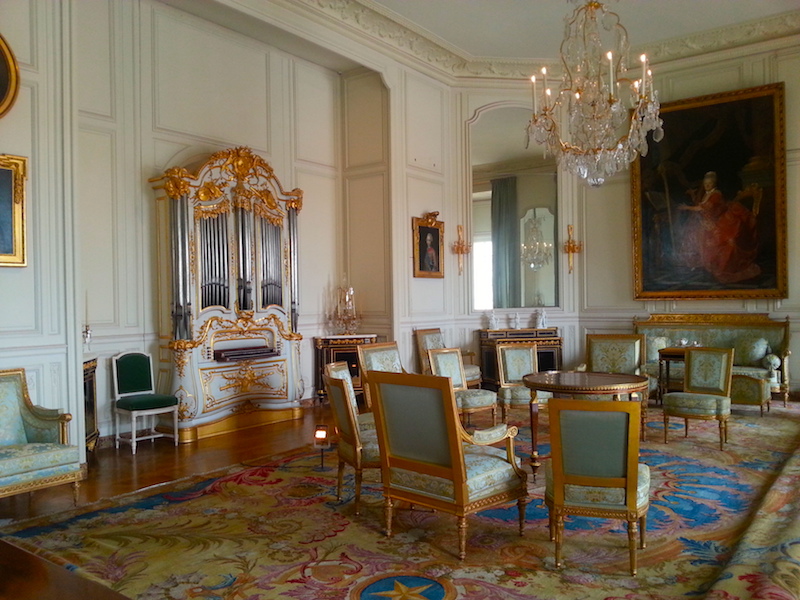
Mme Adélaïde’s music room.
The most striking element of the room is the elaborate organ, one of 3 ordered from the organ-maker Nicolas Sommer in 1747. The others belonged to Madame’s brother the Dauphin (1729-1765) and her sister-in-law the Dauphine (1731-1767), the parents of Louis XVI, Louis XVIII, and Charles X. This organ has been positively identified as Mme Adélaïde’s because the initials ‘MA’ (Marie-Adélaïde) were found on the back during its restoration. The sisters were keen and apparently rather gifted musicians. The large portrait on the far wall (see above) depicts Mme Victoire at her harp, an instrument also played by Marie-Antoinette.
From this room, there is a discreet exit into the Salle des Hoquetons, the room of the palace police.
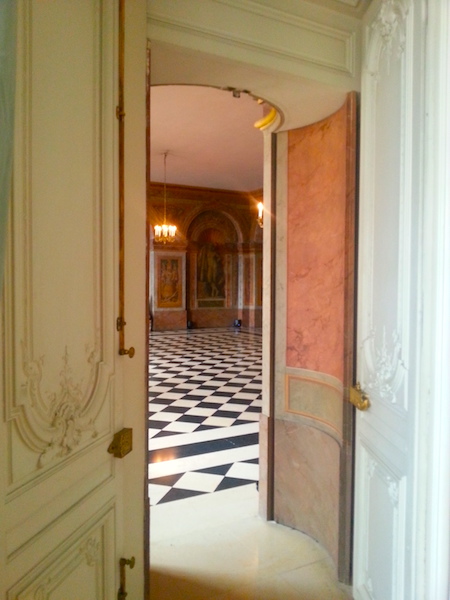
View into the Salle des Hoquetons from Mme Adélaïde’s grand cabinet.
Sadly, Mesdames had to spend their final years on the run. At the outbreak of the Revolution, they retreated to their Bellevue estate. From there, they fled in 1791 to Turin, where they were sheltered by the Sardinian royal family, their relations. Eventually, they moved on to Rome, and then Naples, where Marie-Antoinette’s sister Maria Carolina was queen consort. She was apparently not pleased to see them — understandably, since they had made life difficult for her sister, particularly Mme Adélaïde, who had been the leader of the ‘devout’ party at Versailles. As the Revolutionary wars came closer, the sisters were obliged to flee once more, this time to Trieste. Mme Victoire died there of breast cancer in 1799 and Mme Adélaïde followed her to the grave the following year. After the Restoration, their nephew Louis XVIII had their remains interred in the royal crypt at St. Denis in Paris.
I hope you’ve found this post interesting and informative. If you’ve visited Mesdames’ apartments, please share your impressions below, on the Versailles Century Facebook page, or in our gallery on Instagram (@versailles_century).
NB Nearly all the information in this post comes from a PDF file on Mesdame’s rooms that was prepared for the re-opening of the rooms in 2013 after a thorough restoration. You can download it from the Château de Versailles website here:
http://www.chateauversailles.fr/resources/pdf/en/presse/dp_mesdames_en.pdf







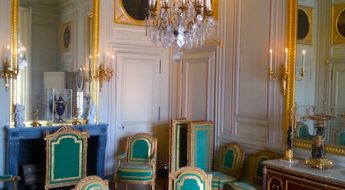









Leave a Comment